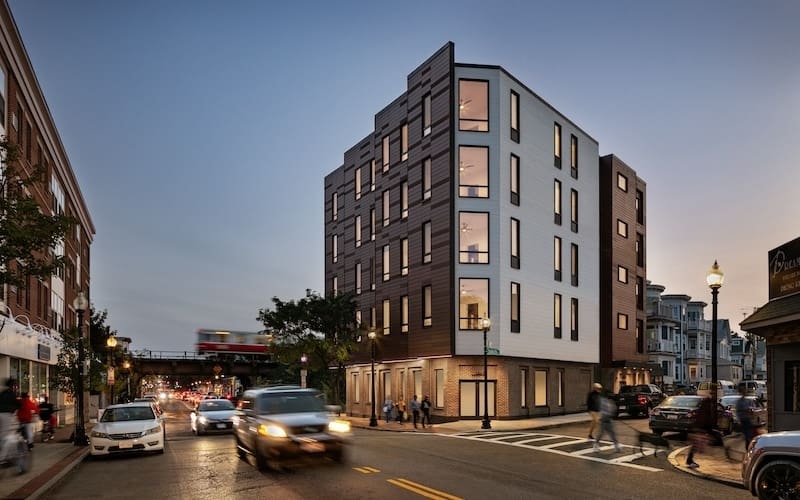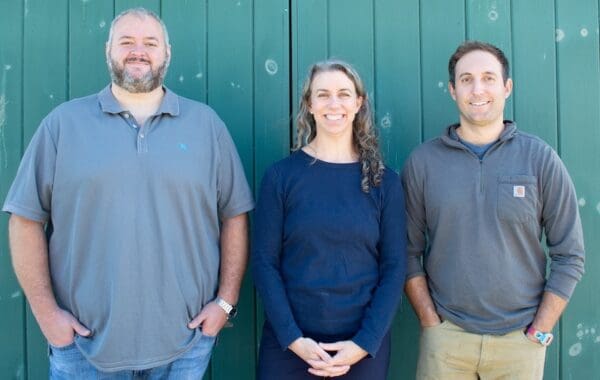
The Dot Crossing apartment complex in Fields Corner, Dorchester allows residents easy access to the T. Courtesy: J. Garland Enterprises
Two minutes. That’s all it takes to reach the MBTA commuter rail station from the new apartment complex at 191 Talbot Avenue in Boston’s Dorchester neighborhood. And in many respects, that quick walk is life-changing. Residents living in the tidy development of 14 apartments can finish that novel, chat with a friend, or tackle a crossword puzzle on a train to work – all without the hassle of sitting in traffic. (They can also take a bus that runs right outside their door.) Neighbors enjoy streets that are a little less congested. The city savors air that’s just a little cleaner.
In fact, the Talbot Avenue development, completed in 2022 with the help of CLF’s Healthy Neighborhoods Equity Fund (HNEF), is just one example of a growing movement to link housing to public transit. CLF is encouraging developers to adopt a more holistic approach, integrating housing into a supportive urban context that improves the lives of not just residents but the city as a whole.
“It’s a win-win situation,” says Alex Linkow, senior manager of impact investment at CLF. “That’s why CLF has pushed so hard to see more of this holistically planned, climate-friendly housing built. If given the opportunity, many of us would choose to live in walkable neighborhoods near public transit. Unfortunately, affordable housing in that kind of walkable context is not easy to find.”
Housing with climate front of mind
The 14 units at 191 Talbot were created through a partnership between CLF and the Massachusetts Housing Investment Corporation, or MHIC. Together, the organizations established an equity fund to tackle big intersectional issues like climate change, public health, and housing stability. Since launching its first equity fund about 12 years ago, CLF and MHIC have started two more funds that support environmentally sustainable, mixed-income housing near public transit. To date, they have raised over $74 million.
The goal is to encourage developers to build mixed-income housing where residents no longer must take on the extra expense of owning a car and where they can walk to shops and parks, improving their health and well-being.
The philosophy is already bearing fruit. Since the initial equity funds were created, CLF and MHIC have funded 16 mixed-use housing developments that are affordable, sustainable, and walkable.
Climate-friendly housing, from Dorchester to Pawtucket
Among those developments is Dot Crossing in the Fields Corner neighborhood of Boston, where 29 moderately priced apartments sit a stone’s throw from the Fields Corner MBTA station. There’s also Northampton Residences in the Lower Roxbury neighborhood, where a second equity fund – HNEF II – made a $4.9 million investment to build 47 condominiums next to the Southwest Corridor Park and within 400 feet of the Massachusetts Avenue Orange Line station. One of the latest developments is in Pawtucket, Rhode Island, where CLF and MHIC made an $8.35 million investment to build 150 units of all-electric housing through their third fund. When the $55 million project is complete, it will also boast commercial spaces and easy walking access to the new Pawtucket-Central Falls commuter rail station and downtown Pawtucket.
Because these developments are heated and cooled with electricity, they emit less carbon pollution into the air compared with buildings that use natural gas or oil. They incorporate the latest in green design, like white roofing to reduce the heat that can build up in cities. They also feature other environmentally friendly elements, such as solar-ready rooftops and charging stations for electric vehicles. Depending on the development, apartments are offered to anyone making 80% to 100% of the area’s median income.
“Our aim is to help communities thrive,” says Linkow. “And our health and well-being is intimately connected to the health and well-being of the environment.”
Thinking Holistically About Where We Live
Of course, while green design and proximity to public transit are key, if developers hope to provide residents with a healthy lifestyle, they must also facilitate access to other essential goods and services, like healthy food and parks. In Pawtucket, Dexter Commons will sit not only close to commuter rail, but also within a half-mile of a grocery store, a farmers market, public parks, and green spaces.
Likewise, at 191 Talbot, the Fresh Food Generation Caribbean restaurant and catering business occupies the building’s first-floor retail space, making a healthy, tasty meal – such as roasted vegetables, grilled chicken, and sautéed collard greens – an easy option for residents on the go.
“We’re so thankful to be able to move into this space where the community has expressed wanting us to be there,” says Fresh Food Generation founding partner Cassandria Campbell.
A housing complex is not an island
In the end, says Linkow, a housing complex is not an island. Rather, it is critical to incorporate housing into a neighborhood fabric that includes transit, markets, shops, and services. Before the advent of the car, this was a given. Now, as we fight to slow climate change, we must return to this conception of cities and neighborhoods.
“Addressing issues like access to transportation, land use, and energy-efficient buildings is key to fighting climate change and improving health,” says Linkow. “Our Healthy Neighborhoods Equity Funds help fill the funding gap to create healthier, more sustainable communities so we can live without being bound to a car.”



